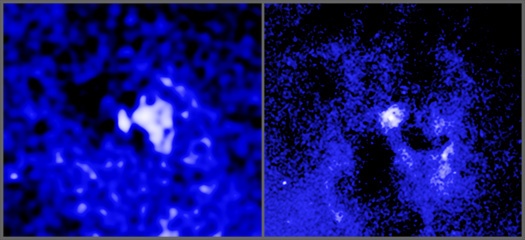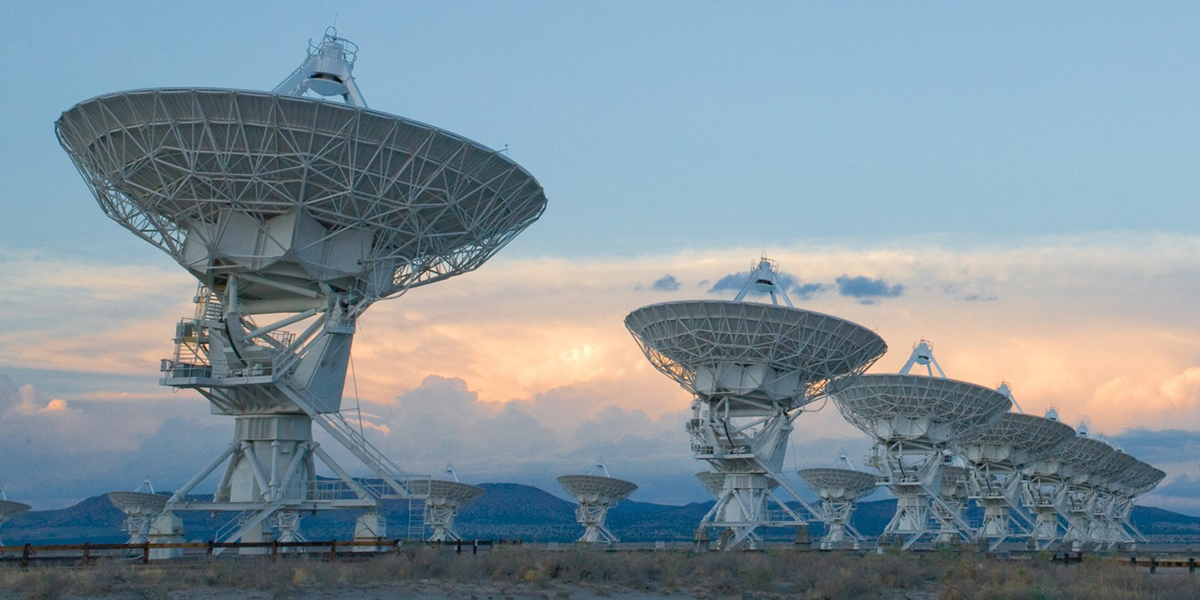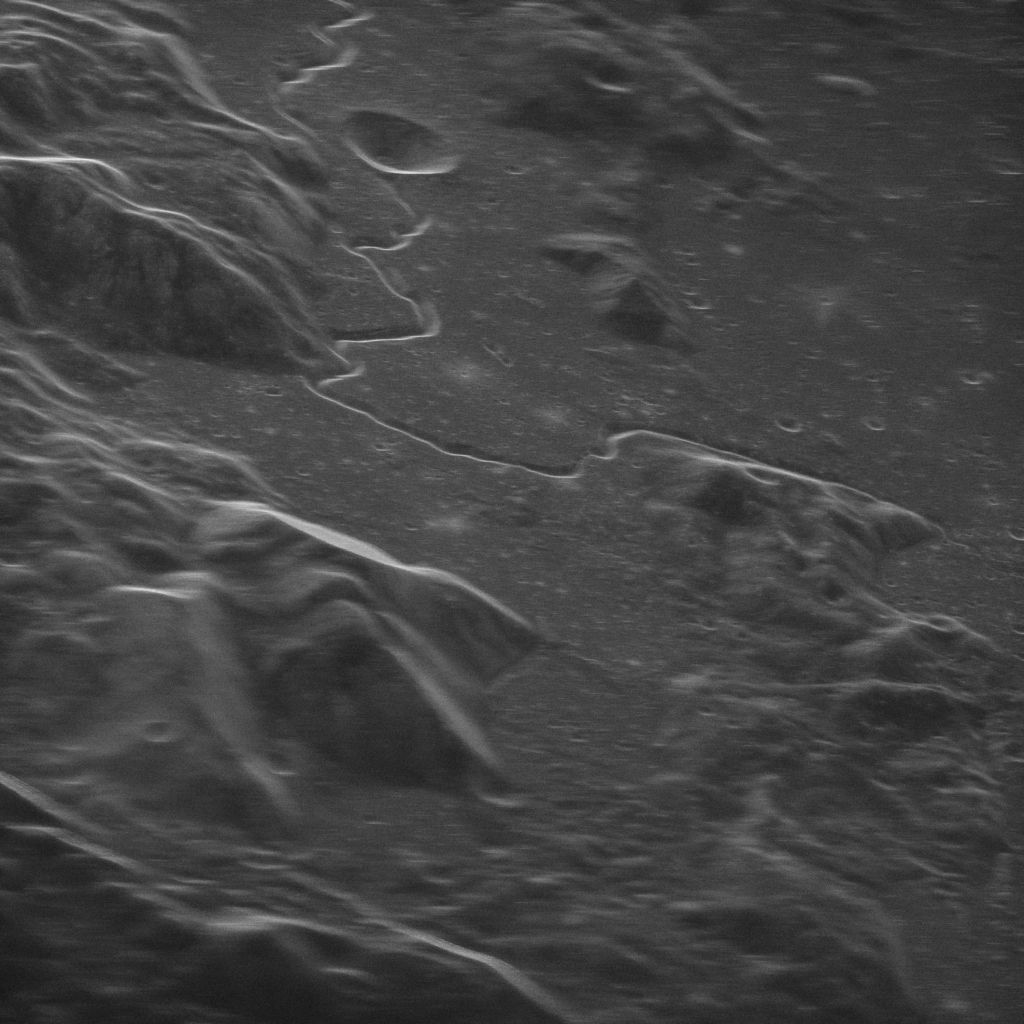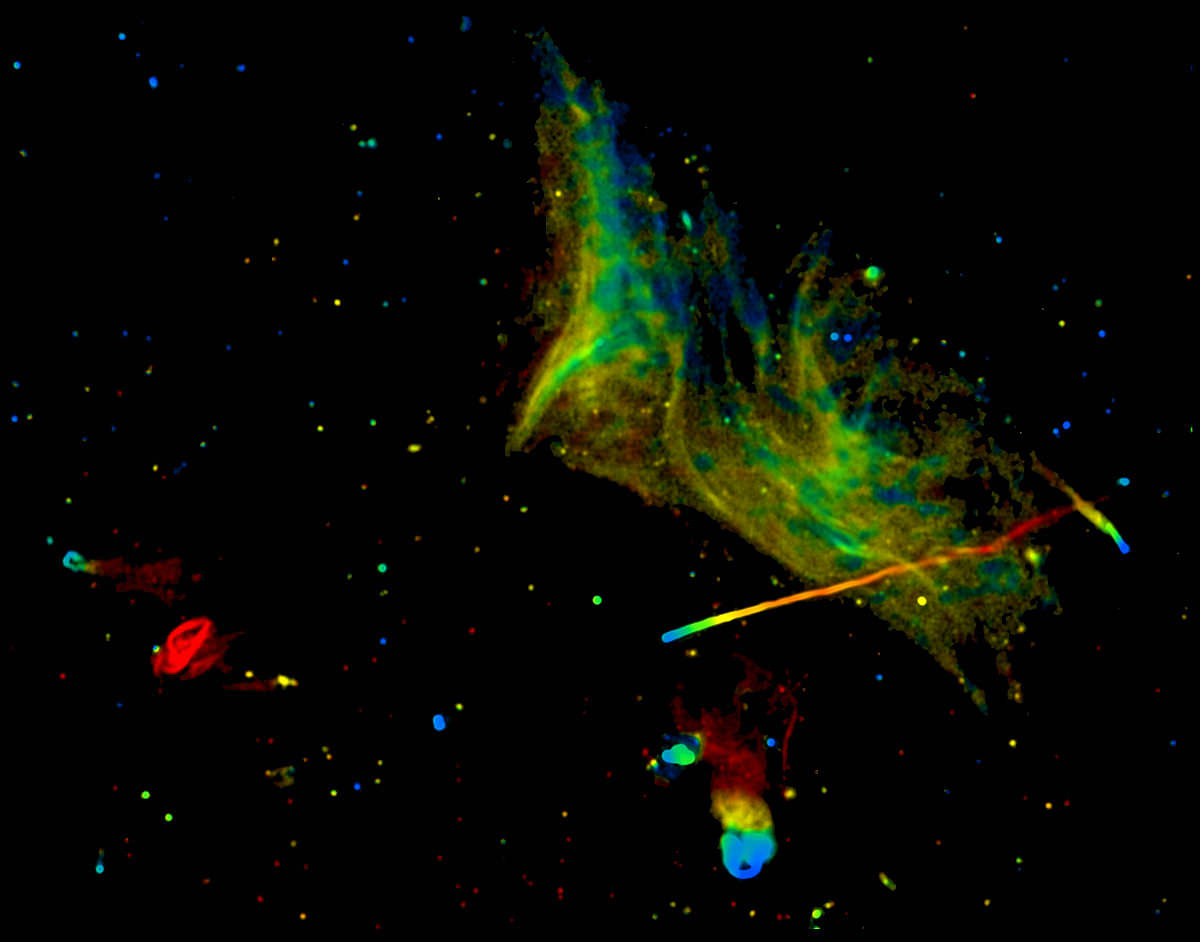Black holes seem to provide endless fascination to astronomers. This is at least partly due to the extreme physics that takes place in and around them, but sometimes, it might harken back to cultural touchpoints that made them interested in astronomy in the first place. That seems to be the case for the authors of a new paper on the movement of jets coming out of black holes. Dubbing them “Death Star” black holes, researchers used data from the Very Long Baseline Array (VLBA) and the Chandra X-ray Observatory to look at where these black holes fired jets of superheated particles. And over time the found they did something the fiction Death Star could also do – move.
Continue reading “Black Holes are Firing Beams of Particles, Changing Targets Over Time”A Sneak Peek at the Next Generation Very Large Array’s New Antennae
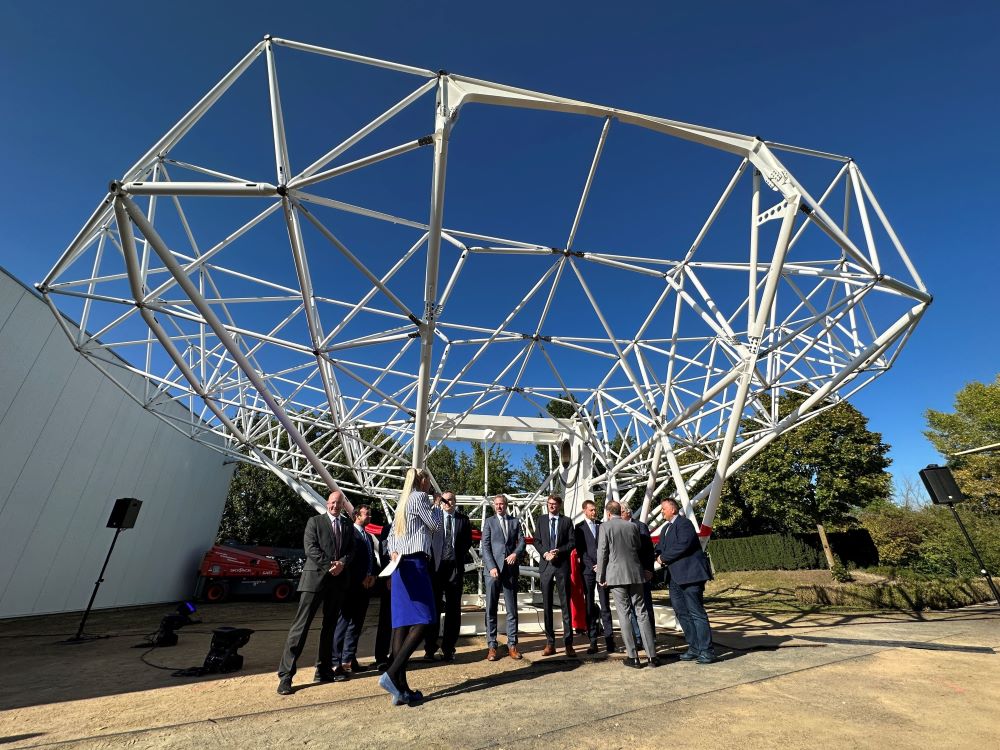
The National Radio Astronomy Observatory (NRAO) recently disclosed a prototype radio telescope antennae for its next generation Very Large Array (ngVLA) to a group of press, scientists, engineers, and government and business leaders from the United States and Germany at the end of a workshop held at the Max Planck Institute for Mathematics in the Sciences in Leipzig. While construction on the ngVLA isn’t slated to begin until 2026, this recent unveiling provided an opportunity for mtex antenna technology to present its 18-meter dish, which consists of 76 individual aluminum panels arranged in an 8-sided shape.
Continue reading “A Sneak Peek at the Next Generation Very Large Array’s New Antennae”A Green Bank Telescope Prototype Radar System Can Image the Moon in High-Resolution and Detect Asteroids

Everyone loves taking pictures of the Moon. Whether it’s with their phones or through the wonders of astrophotography, photographing the Moon reminds us about the wonders and awesomeness of the universe. But while we can take awesome images of the whole Moon from the Earth, it’s extremely difficult to get close-up images of its surface given the enormous distance we are from our nearest celestial neighbor at 384,400 km (238,855 mi). This is because the closer we try to zoom in on its surface, the blurrier, or more pixelated, the images become. Essentially, the resolution of the images becomes worse and worse. But what if we could take high-resolution images of the Moon’s surface from Earth instead of relying on satellites presently in lunar orbit to take them for us?
Continue reading “A Green Bank Telescope Prototype Radar System Can Image the Moon in High-Resolution and Detect Asteroids”SETI Researchers can now Scan all Data at the Very Large Array for any Evidence of Alien Transmissions
On February 14th, 2020, the SETI Insitute and the National Radio Astronomy Observatory (NRAO) announced a new partnership, which they appropriately named the Commensal Open-Source Multimode Interferometer Cluster Search for Extraterrestrial Intelligence (COSMIC SETI). This partnership will allow the Karl G. Jansky Very Large Array (VLA) to participate in the Search for Extraterrestrial Intelligence (SETI) for the first time in its history.
In recent weeks, the project took a big step forward with the installation of fiber optic amplifiers and splitters on all VLA antennas, which give COSMIC access to the data streams from the entire VLA. Once this digital backend is online, COSMIC will have access to all data provided by the VLAs 27 radio antennas, which will be able to conduct observations 24/7. In the process, COSMIC SETI will examine around 40 million stars in the Milky Way for possible signs of intelligent life.
Continue reading “SETI Researchers can now Scan all Data at the Very Large Array for any Evidence of Alien Transmissions”The Next Generation Very Large Array Would be 263 Radio Telescopes Spread Across North America
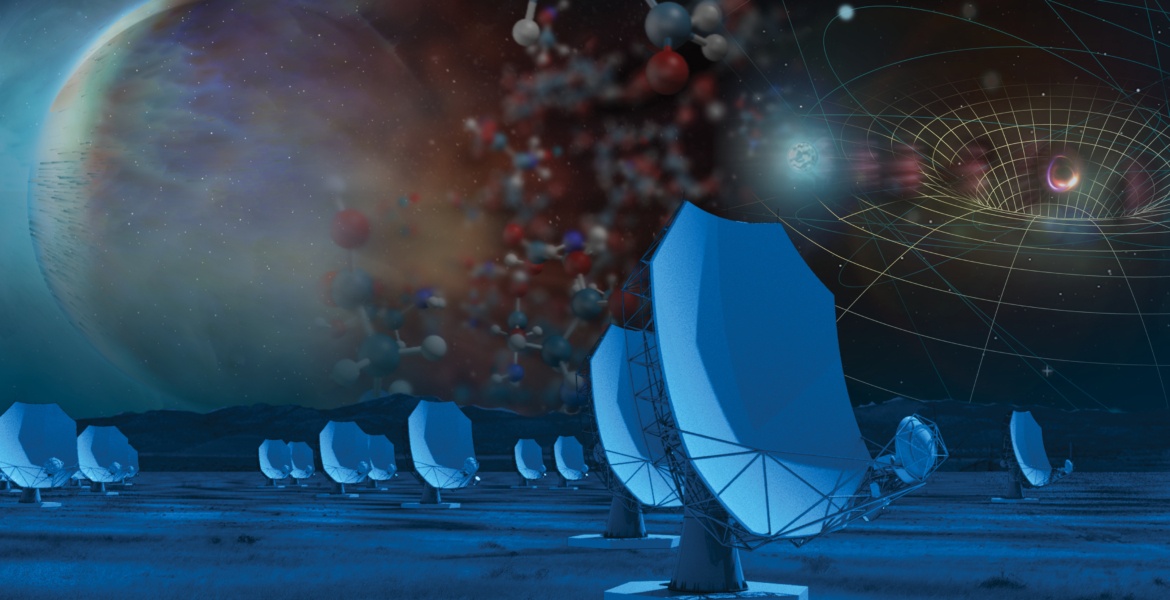
The iconic Very Large Array (VLA) in New Mexico has been at the forefront of astrophysical research since its dedication in 1980. The Y-shaped configuration of 27 radio astronomy dishes have made key discoveries about the cosmos, while becoming a part of pop-culture in several high-profile movies.
But the aging array is due for an upgrade, one that would take advantage of advanced technology. So says the latest Decadal Survey, published by the U.S. National Academy of Sciences, which presents a consensus among researchers on the most important scientific goals and missions for the upcoming decade.
Continue reading “The Next Generation Very Large Array Would be 263 Radio Telescopes Spread Across North America”A New Radar Instrument Will Try To Fill the Void Left By Arecibo
Observational astronomy is dependent on its data, and therefore also dependent on the instruments that collect that data. So when one of those instruments fails it is a blow to the profession as a whole. The collapse of the Arecibo Telescope last year after it was damaged by Hurricane Maria in 2017 permanently deprived the radio astronomy world of one of its primary observational tools. Now a team at the National Radio Astronomy Observatory (NRAO) hopes to upgrade an existing telescope at the Green Bank Observatory in West Virginia to replace the failed Puerto Rican one and provide even more precise images of near Earth objects in the radio spectrum.
Continue reading “A New Radar Instrument Will Try To Fill the Void Left By Arecibo”Pulsar Seen Speeding Away From the Supernova That Created it

When a star exhausts its nuclear fuel towards the end of its lifespan, it undergoes gravitational collapse and sheds its outer layers. This results in a magnificent explosion known as a supernova, which can lead to the creation of a black hole, a pulsar or a white dwarf. And despite decades of observation and research, there is still much scientists don’t know about this phenomena.
Luckily, ongoing observations and improved instruments are leading to all kinds of discoveries that offer chances for new insights. For instance, a team of astronomers with the National Radio Astronomy Observatory (NRAO) and NASA recently observed a “cannonball” pulsar speeding away from the supernova that is believed to have created it. This find is already providing insights into how pulsars can pick up speed from a supernova.
Continue reading “Pulsar Seen Speeding Away From the Supernova That Created it”If You Could See in Radio These Are the Crazy Shapes You’d See in the Sky
Even though it’s said that the average human eye can discern from seven to ten million different values and hues of colors, in reality our eyes are sensitive to only a very small section of the entire electromagnetic spectrum, corresponding to wavelengths in the range of 400 to 700 nanometers. Above and below those ranges lie enormously diverse segments of the EM spectrum, from minuscule yet powerful gamma rays to incredibly long, low-frequency radio waves.
Astronomers observe the Universe in all wavelengths because many objects and phenomena can only be detected in EM ranges other than visible light (which itself can easily be blocked by clouds of dense gas and dust.) But if we could see in radio waves the same way we do in visible light waves – that is with longer wavelengths being perceived as “red” and shorter wavelengths seen as “violet,” with all the blues, greens, and yellows in between – our world would look quite different… especially the night sky, which would be filled with fantastic shapes like those seen above!
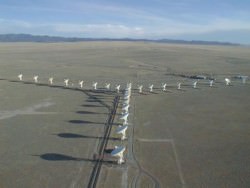
Created from observations made at the Very Large Array in New Mexico, the image above shows a cluster of over 500 colliding galaxies located 800 million light-years away called Abell 2256. An intriguing target of study across the entire electromagnetic spectrum, here Abell 2256 (A2256 for short) has had its radio emissions mapped to the corresponding colors our eyes can see.
Within an area about the same width as the full Moon a space battle between magical cosmic creatures seems to be taking place! (In reality A2256 spans about 4 million light-years.)
See a visible-light image of A2256 by amateur astronomer Rick Johnson here.
The VLA radio observations will help researchers determine what’s happening within A2256, where multiple groups of galaxy clusters are interacting.
“The image reveals details of the interactions between the two merging clusters and suggests that previously unexpected physical processes are at work in such encounters,” said Frazer Owen of the National Radio Astronomy Observatory (NRAO).

Learn more about NRAO and radio astronomy here, and you can get an idea of what our view of the Milky Way would look like in radio wavelengths on the Square Kilometer Array’s website.
Source: NRAO
Weekly Space Hangout – February 20, 2015 – Charles Black from SEN
Host: Fraser Cain (@fcain)
Guests:
Ramin Skibba (@raminskibba)
Dave Dickinson (@astroguyz / www.astroguyz.com)
Special Guest: Charles Black (@charlesblack / sen.com/charles-black)
Continue reading “Weekly Space Hangout – February 20, 2015 – Charles Black from SEN”
“Vampire” Galaxy Sucks Star-Forming Gas from its Neighbors
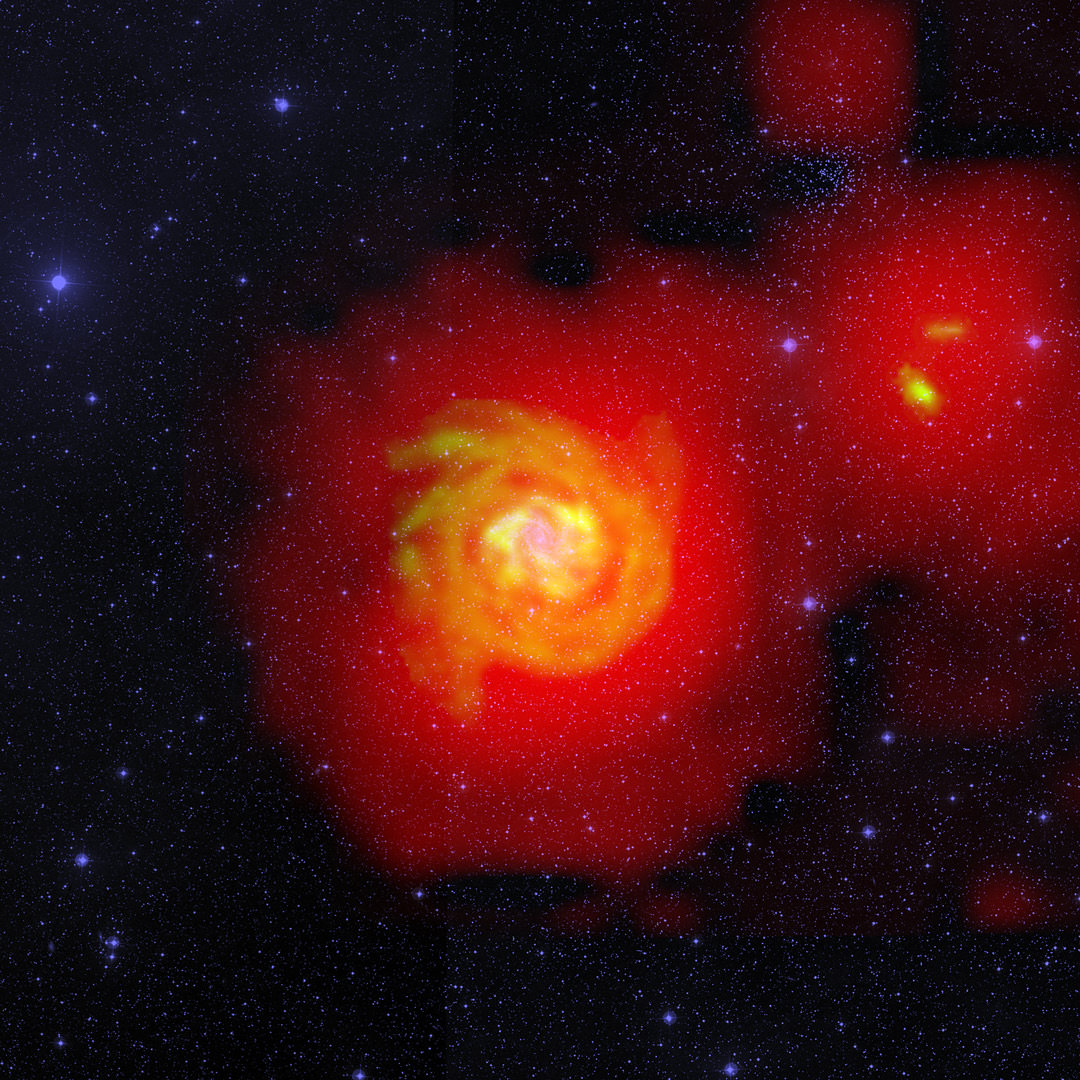
What happens when a galaxy doesn’t have enough hydrogen to support its stellar production process? Why, it sucks it from its hapless neighbors like some sort of cosmic vampire, that’s what. And evidence of this predatory process is what’s recently been observed with the National Science Foundation’s Robert C. Byrd Green Bank Telescope (GBT) in West Virginia, in the form of faint “cold flows” bridging intergalactic space between the galaxy NGC 6946 and its smaller companions.
“We knew that the fuel for star formation had to come from somewhere,” said astronomer D.J. Pisano from West Virginia University, author of the study. “So far, however, we’ve detected only about 10 percent of what would be necessary to explain what we observe in many galaxies. A leading theory is that rivers of hydrogen – known as cold flows – may be ferrying hydrogen through intergalactic space, clandestinely fueling star formation. But this tenuous hydrogen has been simply too diffuse to detect, until now.”
NGC 6946 also goes by the festive moniker of “the Fireworks Galaxy,” due to the large amount of supernovae that have been observed within its arms — eight within the past century alone. Located 22 million light-years away between the constellations Cepheus and Cygnus, NGC 6946’s high rate of star formation has made astronomers curious as to how it (and other starburst galaxies like it) gets its stellar fuel.
One long-standing hypothesis is that large galaxies like NGC 6946 receive a constant supply of hydrogen gas by drawing it off their less-massive companions.
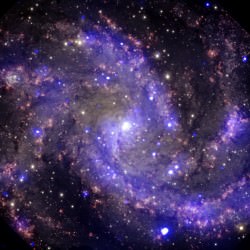
Now, thanks to the GBT’s unique capabilities — such as its immense single dish, unblocked aperture, and location in the National Radio Quiet Zone — direct observations have been made of the extremely faint radio emissions coming from neutral hydrogen flows connecting NGC 6946 with its smaller satellite galaxies.
According to a press release from the National Radio Astronomy Observatory:
Earlier studies of the galactic neighborhood around NGC 6946 with the Westerbork Synthesis Radio Telescope (WSRT) in the Netherlands have revealed an extended halo of hydrogen (a feature commonly seen in spiral galaxies, which may be formed by hydrogen ejected from the disk of the galaxy by intense star formation and supernova explosions). A cold flow, however, would be hydrogen from a completely different source: gas from intergalactic space that has never been heated to extreme temperatures by a galaxy’s star birth or supernova processes.
Another possible source of the cold flow is a previous collision with another galaxy, possibly even one of its own satellites, which would have left strands of atomic hydrogen in its wake. But if that were the case stars would likely have since formed within the filaments themselves, which has not yet been observed.
Pisano’s findings have been published in the Astronomical Journal.
Source: NRAO press release. Learn more about the Green Bank Telescope here.
Image credit: D.J. Pisano (WVU); B. Saxton (NRAO/AUI/NSF); Palomar Observatory – Space Telescope Science Institute 2nd Digital Sky Survey (Caltech); Westerbork Synthesis Radio Telescope

